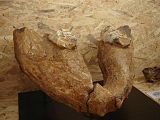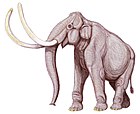互棱齒象屬
| 互棱齒象屬 | |
|---|---|

| |
| 互棱齒象(A. arvernensis)骨架化石 | |
| 科学分类 | |
| 界: | 动物界 Animalia |
| 门: | 脊索动物门 Chordata |
| 纲: | 哺乳纲 Mammalia |
| 目: | 长鼻目 Proboscidea |
| 科: | †互棱齒象科 Anancidae |
| 属: | †互棱齒象屬 Anancus Aymard, 1855 |
| 種 | |
| |
互棱齒象屬(學名:Anancus)為長鼻目互棱齒象科下已滅絕的一屬,生存於中新世晚期至更新世早期(約700-150萬年前)的非洲、歐洲與亞洲。
分類學[编辑]


互棱齒象屬為互棱齒象科的模式屬,最早由奧古斯特·艾馬德於1855年命名,最早被分類於嵌齒象科下,但在之後由McKenna & Bell (1997)、Kalb & Froelich (1995)、Shoshani & Tassy (2005)改分類至象科。之後Hautier et al. (2009)將互棱齒象屬分類於嵌齒象科的互棱齒象亞科下[1]。近年,互棱齒象屬與其他同樣原屬於嵌齒象科的四稜齒象演化支被移出嵌齒象科並分類至獨立的互棱齒象科下[2][3][4]。
描述[编辑]
互棱齒象屬肩高可達3米(9.8英尺),體重可達55公噸(4.9長噸;5.5短噸),外型與現存大象近似[5],但四肢較短,且具有較長的象牙,最長可達4米(13英尺)[6],可能是可用以自我防衛,和現今的大象類似[7][8]。互棱齒象的臼齒和現今的大象不同,不具有皺褶,而是具有牙尖,類似於貘或豬的臼齒。互棱齒象棲息於森林,推測牠們是以樹和灌木還有挖掘地下的塊莖與塊根為食,當森林逐漸被草原取代時,互棱齒象也走向滅絕[6];然而從300-400萬年前衣索比亞互棱齒象牙齒化石琺瑯質中的碳同位素分析卻顯示,牠們主要是以C4類植物為食[9]。
圖庫[编辑]
-
互棱齒象下顎化石
-
互棱齒象(Anancus arvernensis)下顎化石,發現於義大利第四紀地層
-
互棱齒象(Anancus arvernensis)臼齒化石
參考文獻[编辑]
- ^ Hautier, Lionel; Mackaye, Hassane Taisso; Lihoreau, Fabrice; Tassy, Pascal; Vignaud, Patrick; Brunet, Michel. New material of Anancus kenyensis (proboscidea, mammalia) from Toros-Menalla (Late Miocene, Chad): Contribution to the systematics of African anancines. Journal of African Earth Sciences. March 2009, 53 (4–5): 171–176. Bibcode:2009JAfES..53..171H. doi:10.1016/j.jafrearsci.2009.01.003.
- ^ Shoshani, Jeheskel; Tassy, Pascal. Advances in proboscidean taxonomy & classification, anatomy & physiology, and ecology & behavior. Quaternary International. January 2005,. 126-128: 5–20. Bibcode:2005QuInt.126....5S. doi:10.1016/j.quaint.2004.04.011.
- ^ Shoshani, J.; Tassy, P. Summary, conclusions, and a glimpse into the future. Shoshani, Jeheskel; Tassy, Pascal (编). The Proboscidea: Evolution and Palaeoecology of Elephants and Their Relatives. Oxford University Press. 1996: 335–348. ISBN 978-0-19-854652-8.
- ^ Mothé, Dimila; Ferretti, Marco P.; Avilla, Leonardo S. The Dance of Tusks: Rediscovery of Lower Incisors in the Pan-American Proboscidean Cuvieronius hyodon Revises Incisor Evolution in Elephantimorpha. PLOS ONE. 12 January 2016, 11 (1): e0147009. Bibcode:2016PLoSO..1147009M. PMC 4710528
 . PMID 26756209. doi:10.1371/journal.pone.0147009.
. PMID 26756209. doi:10.1371/journal.pone.0147009.
- ^ http://donsmaps.com/mastodon.html (页面存档备份,存于互联网档案馆) Mastodons and related early elephants
- ^ 6.0 6.1 Palmer, D. (编). The Marshall Illustrated Encyclopedia of Dinosaurs and Prehistoric Animals. London: Marshall Editions. 1999: 241. ISBN 1-84028-152-9.
- ^ The Free Dictionary: Tusks. [2021-08-07]. (原始内容存档于2022-01-31).
- ^ Upali.ch Elephants in Zoo and Circus (页面存档备份,存于互联网档案馆), Teeth, second dentition, tusks.
- ^ Levin, Naomi E.; Haile-Selassie, Yohannes; Frost, Stephen R.; Saylor, Beverly Z. Dietary change among hominins and cercopithecids in Ethiopia during the early Pliocene. Proceedings of the National Academy of Sciences. 6 October 2015, 112 (40): 12304–12309. Bibcode:2015PNAS..11212304L. PMC 4603467
 . PMID 26371308. S2CID 205272461. doi:10.1073/pnas.1424982112.
. PMID 26371308. S2CID 205272461. doi:10.1073/pnas.1424982112.
- Benes, Josef. Prehistoric Animals and Plants. Prague: Artua. 1979: 263.
| ||||||||||||||||||||||||||||||||||||||||||||||||||||||||||||||||||||||||||||||||||||||||||||||||||||||||||||||||||||||
|







